Calculation of a brick for a house
Any construction is highly dependent on competent planning. Brick building is no exception to this rule. In addition to the competent organization of construction work, it is also necessary to be able to correctly determine the required volume of building materials, first of all.
What affects the consumption of bricks when building a house
The consumption of bricks for building a house depends mainly on the type of brick and on the method of laying (that is, the thickness of the wall). There are ordinary (single), thickened (one and a half) and double bricks. Even at the preparatory stage, it is necessary to determine the type of brick used and the method of laying, the method for calculating the required number of bricks will depend on this.

Most often, for the load-bearing walls of houses located in areas with a temperate and cold climate, a wall with a thickness of 2.0 or 2.5 bricks is chosen. Laying in this case can be done in several ways:
- you can use a single brick. From an aesthetic point of view, this is the best option for a wall if it is not planned to be plastered or additionally insulated from the outside.
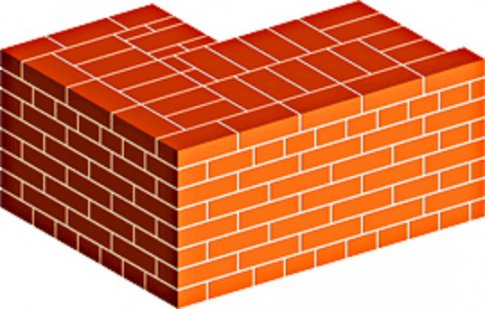
- You can use a thickened or even double brick along with a single cladding. This method allows you to save on the cost of materials, since the cost of a double brick is much less than the cost of a single brick for the same amount of construction.
Brick calculation methods - easier than on a calculator
The most common mistake newbies make during the planning phase is not taking into account the volume of mortar joints when calculating the number of bricks per house. Due to this, the result is 20 - 30% higher than the actual need for building materials.
The thickness of the mortar joint is about 5 - 10 mm, due to this, in one cubic meter of masonry, about 20 - 30% of the volume falls on mortar joints.
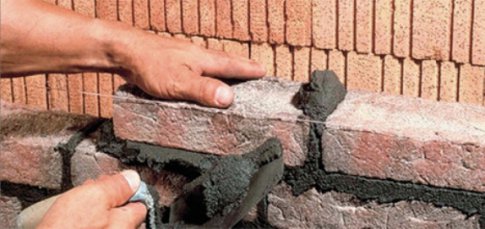
When calculating the required number of bricks, you can go in two ways:
- use the dimensions of the brick, but increase them by the size of the mortar joint;
- use the average brick consumption per cube or square meter of masonry. This greatly simplifies the task and gives a fairly high accuracy. Given the number of bricks required to build a house, an error of 2 - 3% does not play a big role.

Such a task as calculating a brick for a house is solved in several stages:
- The area of the outer and inner walls is calculated (given that, most likely, the thickness of the walls is different, the calculation should be carried out separately).
- The area of openings for windows and doors is calculated.
- The area of external and internal walls is calculated taking into account the area of \u200b\u200bwindows and doors.
- Knowing the thickness of the outer and inner walls, a separate volume of the outer and inner walls is calculated.
- Taking into account the average consumption of bricks per cube or square meter of masonry, the required number of bricks for building a house is calculated.
Depending on the type of masonry, either the masonry area or its volume can be used in the calculations. They work with the area if lightweight masonry is used.
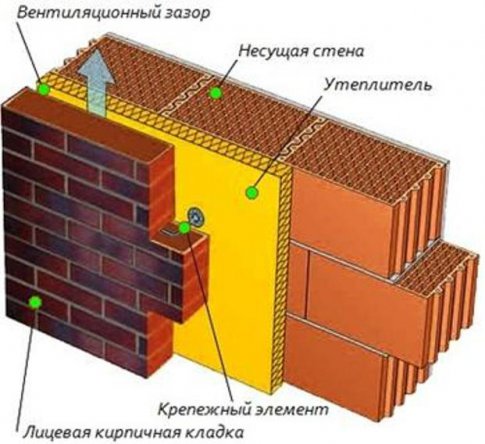
That is, 2 thin walls are erected (from a single brick), and the space between them is filled with foam concrete, mineral wool or some other insulation. On top of the wall are combined.
The easiest option is to calculate the required number of bricks using an online calculator.
An example of calculating the number of bricks for a house
As an example, a project of a 2-storey house with a ceiling height of 3.0 m will be used, so the height of the load-bearing walls is 6.0 m, the length of each is 10.0 m. The thickness of the load-bearing walls is 2.5 bricks (or 64 cm ), 1 brick (25 cm) masonry will be used for interior walls. For load-bearing walls, laying of 2.0 bricks will be made of double bricks, the last row of 0.5 bricks will be made of single facing bricks. For internal walls, a single brick is used (masonry thickness - 25 cm). The total length of the inner walls is 43 m.
The number of window openings - 9, the dimensions of each - 1.70x1.25 m, the number of doorways (in the outer walls) - 3, the size of each - 2.10x1.20 m. In the inner walls - 5 doorways (2.0x1.20 m).
- the area of external and internal walls is determined. For external walls - 6.0x4x10.0 \u003d 240 m 2, for internal - 43.0x3 \u003d 129.0 m 2;
- area of doors and windows. For external walls, the window area is 9x1.70x1.25 \u003d 19.125 m 2, the area of doorways is 3x2.10x1.20 \u003d 7.56 m 2. For internal walls, the area of doorways is 5x2.0x1.20 = 12 m 2;
- corrected area of external and internal walls. Outdoor - 240 - 19.125 - 7.56 \u003d 213.315 m 2, for internal - 129 - 12 \u003d 117 m 2;
- since 2 different types of bricks are used for the exterior walls, the area of the walls will be used to calculate the number of bricks. For one square of masonry of 2.0 bricks (when using a double brick), 104 bricks are required, the consumption of a single facing brick will be 51 bricks / m 2. Brick consumption for internal walls is 102 pcs / m 2;
- For the outer walls, you will need 213.315x104 = 22185 pieces of double bricks and 213.315x51 = 10880 facing bricks. For internal walls - 117x102 \u003d 11934 pieces of bricks.
Even though brick sizes are standardized, different batches may vary slightly in size. However, it is undesirable to use bricks that differ in size. Therefore, it is recommended to order the required volume of bricks at once, this guarantees the same dimensions of all bricks.
When buying a brick from one batch, the brick is guaranteed to be of the same shade, this is important for facing bricks.
When a brick is delivered, its battle is inevitable, and even during construction, not every brick splits as it should.
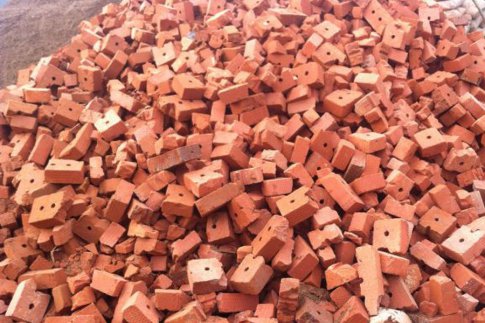
Therefore, when calculating, it is necessary to take into account possible losses. Usually order about 5% more bricks than required by calculation. In the example considered, 23295 double bricks, 11424 facing bricks and 12531 single bricks (for interior walls) should be accepted.
From the point of view of costs, it is much better to pay once for the transportation of all the bricks than to buy the missing volume of building materials later.
The correct calculation of the number of bricks per house is the most important component of the preparatory stage for construction. In the event of a mistake at the most crucial moment, the builder runs the risk of being left without the most important thing, and the construction process will stall for an indefinite period.
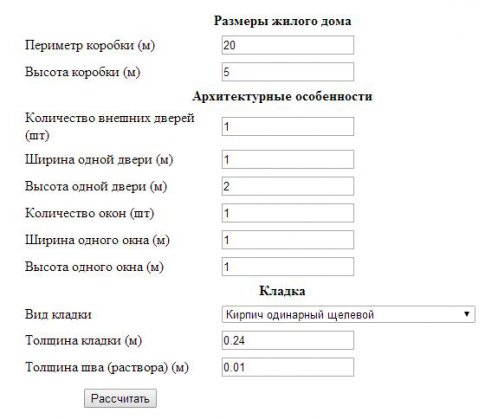
 Masonry mortars for brick kilns
Masonry mortars for brick kilns Why do the windows fog up in the apartment
Why do the windows fog up in the apartment Construction and schemes of brick ovens
Construction and schemes of brick ovens How to lay paving slabs: tips and tricks
How to lay paving slabs: tips and tricks How to drill bathroom tiles
How to drill bathroom tiles Monolithic slab on coarse soil
Monolithic slab on coarse soil Which electric heater is economical
Which electric heater is economical